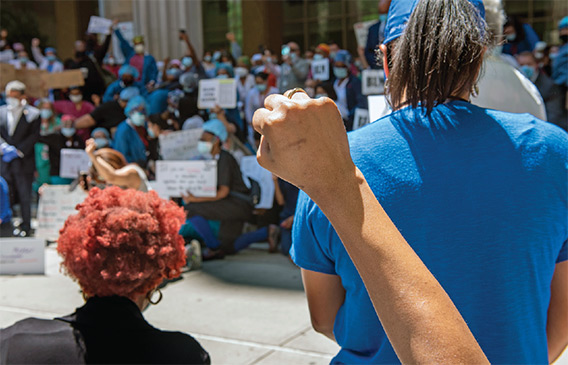Black Docs Matter

We were pleased to read about the extraordinary efforts of VP&S in response to the COVID-19 crisis, including those of the student body (Spring/Summer 2020 issue). For us, what was missing was coverage related to the emerging awareness of the interconnectedness of racism and this pandemic. How has CUIMC responded to the needs of so many front-line workers, who are also people of color? What is the best thinking from the Mailman School of Public Health about what CUIMC should be doing now to respond to patients and community? What about VP&S students of color? The death of George Floyd sparked global protests, including at VP&S. The Black and Latinx Student Organization (BALSO) has been at the forefront of raising awareness about racism and discrimination, advocating for structural and cultural changes and working with the administration for improvements.
BALSO was founded by Michelle Clark’76 and classmates in response to racist graffiti in the lecture halls in 1972. We are pleased that this organization continues to thrive and that there is greater support for the students in general and specifically for those from underrepresented backgrounds. Yet there are still challenges in terms of the numbers of Black and Latinx students and faculty. As alumnae of color, we were disappointed that the alumni magazine mentioned nothing about BALSO or the protests and we hope to see more information in an upcoming issue.
Vivian Lewis’77
Michelle Clark’76
Via email
Editor’s Note: The spring/summer 2020 issue was already in press when the protests began in June. Information about the VP&S response was covered in the 2020 VP&S annual report and is also included in this issue.
Masks for Patient Care
I always enjoy looking through your magazine and catching up on the fine work going on at my alma mater. However, I was shocked to see people (Spring/Summer 2020 issue) wearing respirators (masks) with exhaust valves both on page 25 (top left hand picture) and on the magazine cover (“The Specialist”). These valves make it more comfortable to wear a mask by permitting exhaled air to escape the mask without filtration. This type of mask should never be used in the setting of COVID-19 since it will not protect personnel from a mask wearer with COVID-19, including people with asymptomatic disease.
Most concerning is that the picture on page 25 shows such a mask in use at what appears to be a patient care area. Other pictures raise additional concerns. The picture on the upper right side of page 24 shows that the second person from the left is wearing a surgical mask below, or at best on, the tip of the nose, rather than proper use, which should cover the bridge of the nose. The person on the far right side of this picture is wearing his mask under his chin rather than on his face, although he continues to wear eye protection.
David Alland’80
Rutgers University -
New Jersey Medical School
Editor’s Note: Two readers wrote to ask about the masks shown in some photos, particularly one of the cover images. Columbia Medicine regrets that photo shoots of health care workers and students showed individuals wearing masks in ways that do not reflect proper mask wearing in actual patient care settings.
- Log in to post comments

